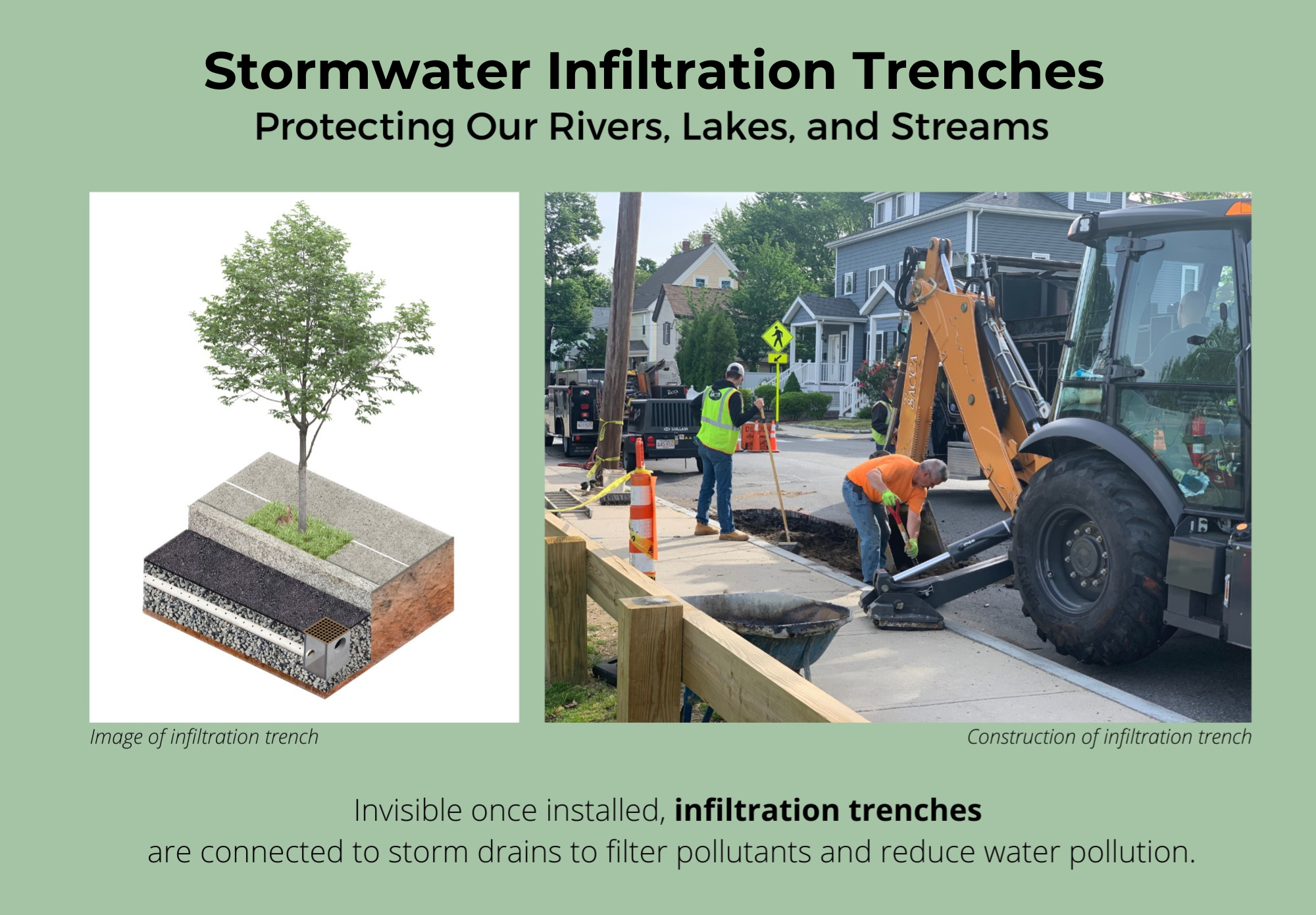Water Quality
We’re working towards healthy waterways that are safe for people to recreate in and provide robust habitat for native species.
Credit: David Mussina
With the help of dedicated volunteers and fellows, we’re collecting data to understand which communities are most impacted by poor water quality and publicizing what we can do about it as a region.
Credit: Horsley Witten Group
We’re working with Town and City engineers on nature-based solutions to improve water quality. From infiltration trenches—which can help address phosphorous—to constructed wetlands that also address climate risks.
Credit: Daria Clark
Many pollutants wash into our waterways with rain and snow melt (stormwater). But the good news—you can do something about it. From adopting a storm drain to rethinking your garden—there are so many ways to get involved.
Monitoring Programs
MyRWA runs many monitoring programs—from our monthly baseline program—to our work to study chloride (road salt) or cyanobacteria. Additionally we report out on these results—using tools such as our water quality report card.
Baseline Monitoring
Since July 2000, MyRWA has been monitoring trends in water quality with the help of a dedicated corps of volunteers. Water samples are collected from fifteen sites across the watershed and are analyzed for: Bacteria: Enterococcus or E. coli; total suspended solids; nutrients: nitrate-nitrite, total phosphorus; conductivity; dissolved oxygen; water temperature and water color and odor.. Resources for monitors here.
Water Quality Report Card
MyRWA, together with the US Environmental Protection Agency (EPA), issues a yearly water quality report card for the Mystic River watershed. Baseline data is used as the basis for this annual water quality report card. Water quality grades are given to sections of the rivers and streams based on how often they comply with state swimming and boating standards.
Boating advisory
During the boating season, estimates of water quality conditions are generated by an automated bacteria prediction model and by additional cyanobacteria testing. The predictions are made each day at 5 AM and are valid for the remainder of the day. To find out if it safe to swim in any of the DCR owned beaches including Shannon Beach, check the DCR Advisory Dashboard.
Cyanobacteria bloom. Photo by Jack Bitney
Cyanobacteria
MyRWA staff and interns monitor cyanobacteria levels throughout the Mystic River Watershed and alert authorities of the potentially harmful bacteria. Cyanobacteria, also referred to as blue-green algae, are photosynthetic bacteria that grow in all types of water and are usually not visible to the naked eye except when they form colonies. Blooms often occur from the late summer to early autumn and can appear overnight.. For more in-depth information about what Cyanobacteria is, how to spot it, and the potential health risks, visit the Centers for Disease Control and Prevention or the Massachusetts Department of Public Health webpage.
Starting in 2017, the Mystic River Watershed Association has engaged in a major phosphorus study, which can cause algal blooms, designed to measure the amount of phosphorus entering the system and the effects it is having.
Road Salt
The potentially harmful component of the salts that gets applied to roads (for example sodium chloride) is chloride, a pollutant that degrades the ecological quality of freshwater systems. Freshwater ecosystems like the Upper Mystic watershed possess a low threshold for heightened levels of chloride. Meaning that an increase in chloride concentrations in water for long periods of time within these ecosystems can create stress and toxic environments for freshwater organisms, from fish to dragonfly larvae to native plants. MyRWA is completing a study on the impacts of road salt and you can read more about it here.
Rain garden capturing stormwater in Arlington.
Green Infrastructure
Green infrastructure is a cost-effective, nature-based approach to managing stormwater impacts that provides many community benefits-like stormwater filtration, improved aesthetics, traffic calming, restored habitat, and building climate resilience.
Infiltration trenches
Infiltration trenches are an innovative and cost-effective approach to reducing a major stormwater pollutant in the watershed: phosphorus. Infiltration trenches are nature-based green infrastructure that reduce runoff by redirecting some of that stormwater to infiltrate the ground. Cost-effective and easy to install, these trenches effectively filter out phosphorous from rain and snowmelt. MyRWA has worked with municipalities to roll out these infiltration trenches across the watershed. So far 98 trenches have been built with many more on the way (60 set for installation and 250 more currently being sited).
Tree Trenches
Tree trenches combine a stormwater infiltration trench with a street tree. This nature-based solution decreases tree mortality and provides co-benefits like increasing tree canopy, cooling neighborhoods, providing habitat, improving water quality, improving air quality, and increasing tree survivability. Click here to learn more about our collaboration with the cities of Everett, Chelsea, and Melrose to pilot this new green infrastructure technology.
Stormwater wetlands
MyRWA is currently working with municipalities on stormwater wetland projects in Everett, Stoneham, Winchester and and Woburn. These open space improvements will help filter pollutants out of rain and snowmelt, provide flood storage during large rainstorms, enhance paths and trails, and expand wildlife habitat.
What Can You Do?
Stormwater pollution occurs when rain or snowmelt washes pollutants such as oil, fertilizers, pet waste and trash over land and into the nearest catch basin, which flows directly to the nearest water body. The US Environmental Protection Agency estimates that contaminants in stormwater runoff cause over half of the pollution in our waterways. The great news is you can help address stormwater pollution! Help us remove trash in your neighborhood—that ends up in our rivers or remember to bag your leaves and reduce or don’t use pesticides or fertilizer. Want to go neighborhood-wide—consider adopting a storm drain—keeping the drain free and clear of trash.











